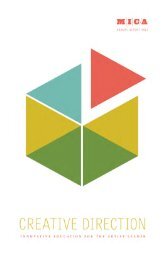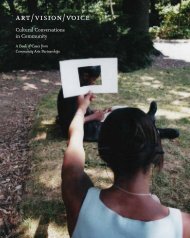Nov.-Dec. 2011 - Maryland Institute College of Art
Nov.-Dec. 2011 - Maryland Institute College of Art
Nov.-Dec. 2011 - Maryland Institute College of Art
Create successful ePaper yourself
Turn your PDF publications into a flip-book with our unique Google optimized e-Paper software.
08 COMMUNITY AND SOCIAL ENGAGEMENT<br />
MICA Heroes in Service<br />
Members <strong>of</strong> the MICA Community Perform Tremendous Feats <strong>of</strong> Community Engagement<br />
tyPiCally, a hero is someone who is willing to be <strong>of</strong> service to others and looks for ways to improve the world around them.<br />
No shortage <strong>of</strong> heroes exist in the MICA community, where artists and designers use their talents for the betterment <strong>of</strong> their<br />
communities and the world. The following pages honor some <strong>of</strong> the heroes who have been nominated by a MICA member.<br />
Sarah Tooley (Photo by Bruce Weller)<br />
One <strong>of</strong> the activities Kayleigh Porter worked on while teaching ceramics<br />
at Good Shepherd Center with nonpr<strong>of</strong>it ceramic art center Baltimore<br />
Clayworks (Photo courtesy Baltimore Clayworks).<br />
Natural Connection<br />
For some, community engagement is a natural outlet for art. Cait Byrnes, a general fine arts<br />
major who graduated in 2010, fulfilled her desire to help others through MICA’s Community <strong>Art</strong><br />
Partnership (CAP), a MICA program that links artists, communities, and organizations. “I did<br />
some work teaching art at a senior housing apartment, and I started an event sophomore year<br />
called CAPfest, which is a celebration <strong>of</strong> all things related to community arts,” she said.<br />
Byrnes’ work with CAP led her to the Community <strong>Art</strong> Collaborative (CAC), an AmeriCorps<br />
program that connects artists, communities, and educational institutions. Through CAC, Byrnes<br />
was placed as a program coordinator at 901 <strong>Art</strong>s, an organization founded upon a successful<br />
partnership between MICA and Baltimore community leaders that provides free after-school programs<br />
in art and music to children <strong>of</strong> the Better Waverly neighborhood. “The process <strong>of</strong> making<br />
art connects everybody,” Byrnes said. “The process <strong>of</strong> working on art together is enough to open a<br />
conversation and create a relationship,” she added.<br />
Joining Byrnes at 901 <strong>Art</strong>s is fellow MICA alumna Sarah Tooley, who serves as director<br />
<strong>of</strong> the organization. “I believe 901 <strong>Art</strong>s is one <strong>of</strong> MICA’s greatest success stories in connecting<br />
with community,” said Tooley, who received an MA in Community <strong>Art</strong>s in 2010. Among the projects<br />
901 <strong>Art</strong>s has completed with community youth is the Sea Creature Storm Drain project,<br />
an effort in which young people painted sidewalk murals <strong>of</strong> sea life around the neighborhood’s<br />
storm drains. The designs brought attention to what happens to underwater life when street<br />
trash and litter are dumped illegally in storm drains or streets since that trash eventually drains<br />
into the Inner Harbor.<br />
A recipient <strong>of</strong> a $49,000 Open Society <strong>Institute</strong> Baltimore Community Fellowship, Tooley<br />
will use the money to further her work at 901 <strong>Art</strong>s. “The point <strong>of</strong> my fellowship is to create a<br />
more sustainable infrastructure for the program,” Tooley said. Among the changes Tooley has<br />
managed to implement: “We created a summer employment program to hire high school teens<br />
from the neighborhood.”<br />
Breaking Barriers, Changing Lives<br />
When Whitney Frazier ’07 arrived in Baltimore from her hometown <strong>of</strong> Plano, Texas, “I was in<br />
shock about what poverty meant and how it was affecting people,” she said. She thought art could<br />
be used as a means for young people in the city to communicate about what they were going<br />
through. “I knew art could break down barriers and change lives,” she said.<br />
While working on her MA in Community <strong>Art</strong>s, Frazier completed her residency at Child First<br />
Authority, Inc., an organization that partners with 17 Baltimore City Public Schools to create<br />
after-school and daytime mentoring programs. Afterwards, Frazier was hired full time as the<br />
community arts coordinator, where she created arts and youth leadership programs, including <strong>Art</strong><br />
Core, a program in which local artists teach art classes in the schools.<br />
The change in the students who discovered an appreciation for art showed Frazier that her<br />
instincts about art’s potential impact were correct. “Child First took it to the next level for me,”<br />
she said, “showing that art can make tangible change for people.”
















